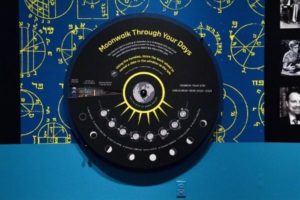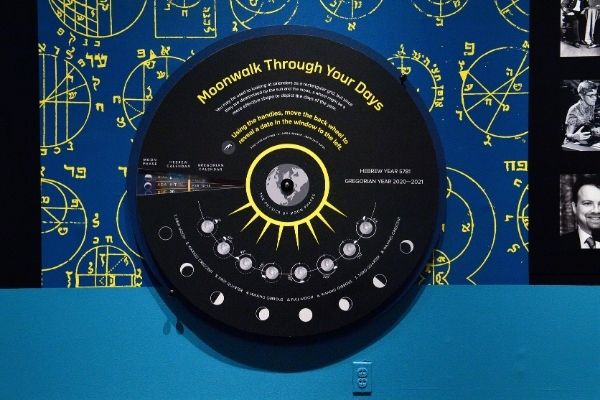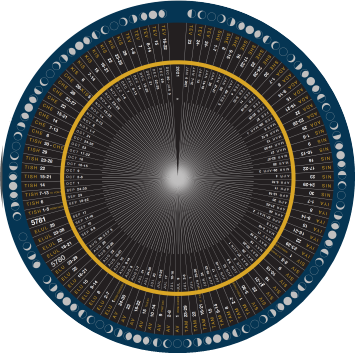Behind the Scenes: Building the Wheel

A blog post by Museum Educator Marisa Shultz! To read more posts from Marisa, click here.

Last week, Museum Educator Alex Malischostak talked about the research and data collection that went into making the Jews in Space: Members of the Tribe in Orbit calendar wheel a reality. The interactive calendar wheel shows the relationship between the Hebrew Calendar, the Jewish Holidays, the moon phases, and the secular Gregorian calendar that most of the world uses today. If you haven’t already, be sure to check out Alex’s blog post here.
Today, however, I want to share with you a behind the scenes look at how our dedicated and tireless team took the data and created the wheel.
It began with an idea. We knew that we wanted a section of the exhibit to address the lunisolar aspects of the Hebrew calendar. And while there are plenty of phone apps and online calculators that can take any Gregorian calendar date and simply show its equivalent Hebrew calendar date (and vice versa), we wanted our visitors to have the opportunity to witness* and experience the relationship between these two calendrical systems and the phases of the moon.
We also knew that we wanted the calendar wheel to encompass both a full Gregorian year and a full Hebrew calendar year, a challenge that Alex mentioned last week, as a standard Hebrew calendar year is slightly shorter than a true solar year.
Lastly, we wanted the wheel to be relevant, and so we weren’t going to pull the calendar dates and moon phases from 50 years ago, or even five years ago; we knew that part of the joy and excitement of the wheel is learning about how all of these pieces fit together right now. So, we set ourselves a goal in which the wheel would encompass the entire time the Jews in Space: Members of the Tribe in Orbit was set to be open.
We divided the calendar into two parts: an inner wheel which is closer to the wall and an outer wheel which is closer to the visitor. The inner wheel has pie wedges for each moon phase for a full solar year and display the corresponding Hebrew and Gregorian calendar dates. However, looking at a 4 ft. wheel with all of these wedges would be super overwhelming and hard to read (take a peek at what the inner wheel looks like on its own below!).

So, instead, we also created an immovable, outer wheel that would sit on top of and cover most of the inner wheel. We then cut a viewing window into the outer wheel so that visitors could see the information of three days at a time. The outer wheel and a nearby panel also include additional context and content, such as the physics behind why the moon phases look the way they do, when the Jewish holidays occur, and a list of the months of the Hebrew calendar. Since the outer wheel acts as an immovable shield, it is actually the inner wheel to which the handles are attached; this also means that the information always appears right side up rather than upside down.
While conceptualizing, researching, designing, and building the calendar wheel all came with challenges, this was an incredibly exciting and rewarding project that I learned a lot working on! I hope that you have the chance to visit the Jews in Space: Members of the Tribe in Orbit exhibit in person and get to explore the oftentimes complicated relationship between these calendars and the cosmos!
*(I have made a too-bad-to-be-funny pun here, as in ancient times individuals had to witness the New Moon in order to determine Rosh Chodesh (the beginning of a new month on the Hebrew calendar).
